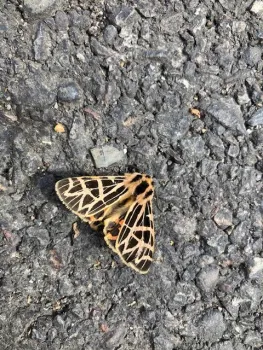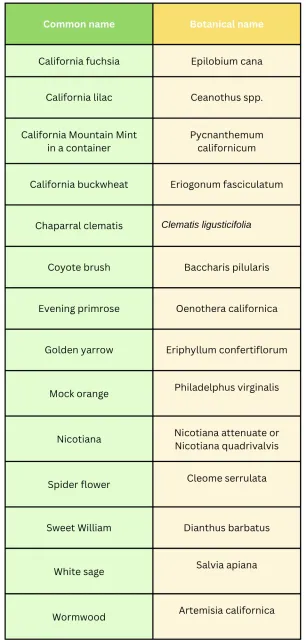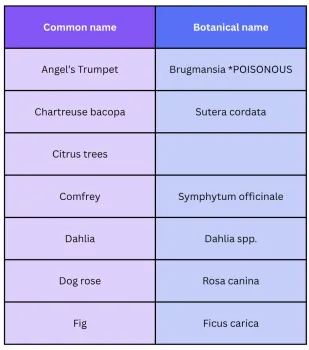Blog by Michelle Davis
Moonscape, moon flower, moon gate, moon garden. All of these I have seen, but moon meadow? New to me! A moon meadow is a green space filled with plants that receive moonlight exposure and attract night-time pollinators like moths, bats and nocturnal bees. (Did you know there are bees that work at night?) A moon meadow doesn’t need to be big. It can even be a container garden.

You may be asking, “Why do I even want to attract moths and bats? Moths and especially their caterpillars can be destructive. And moths are a lot more prevalent than butterflies – about 10x more.” The answer: Moths are important night-time pollinators AND they are an important part of the food chain providing nourishment to lizards, frogs, toads and other amphibians, as well as birds, insects, small mammals and bats. Moth numbers have decreased by at least a third over the last 50 years.

Bats pollinate about 500 different plants many in the tropics and the deserts. Bats also help control insect pest populations, and deposit seeds in their guano as they digest fruit they have eaten. The pollen they transport is flown further distances for cross-pollination and aids genetic diversity. Imagine a world without bats, where growers would have to hand-pollinate bananas, mangoes, and agave for tequila. It is worth providing some space for night-time pollinators.
Making your own moon meadow starts with determining its size. If all you have is a balcony or patio, pot a container that fits the space. If you have a small garden space that can handle more and bigger plants, consider a tree and some smaller shrubs. If you have a larger space, it’s recommended to mow early in the year, plant pollinators and let it grow, not mowing if possible until July and then again only as necessary until Fall starts. During Fall and Winter let the caterpillars and other wildlife survive in the meadow. Resist using pest control and herbicides.
Moonlight is important. Moths can become disoriented by artificial light, wearing them out spinning around the light source, and having no energy left to eat and breed. The plants they would normally choose to eat and pollinate could also be affected by the light pollution. One of the easiest things to do to prevent planet pollution in general is to turn off the lights. A British study revealed that moth caterpillar numbers were over 50% lower in hedgerows under LED streetlights than those under moonlight. If the area has to have some light, focus it straight down and use warm white or amber bulbs. Motion sensors could be a better option.
Some considerations for plants for the new moon meadow include a variety with white or very light-colored flowers, that bloom at night at different times of the year, have a strong scent, are tubular-shaped, are natives, if possible, a plant that supports the ability to provide nectar for the adult moth and food for the caterpillars, too. Generally, these plants have gray or silvery foliage that reflects the moonlight.
Some suggestions that attract moths and other pollinators and are native to California include the following:

Other native plant suggestions: https://californianativeplants.com/wp-content/uploads/2021/08/silver_highlights-1.pdf
https://californianativeplants.com/blog/silver-highlights/
Non-natives include:

All of these plants are beautiful on their own, but in combination, in the moonlight can be not be missed. In addition, silvery foliage plants tend to be drought-tolerant. These are a win-win for the gardener and our nighttime pollinators.
thumbnail photo: "White trumpet flower" by kthypryn is licensed under CC BY 2.0.

